Dyckman Street (IRT Broadway–Seventh Avenue Line)
Dyckman Street | |||||||
|---|---|---|---|---|---|---|---|
 Station platforms | |||||||
| Station statistics | |||||||
| Address | Dyckman Street & Nagle Avenue New York, NY 10034 |
||||||
| Borough | Manhattan | ||||||
| Locale | Inwood | ||||||
| Coordinates | 40°51′40″N 73°55′30″W / 40.861°N 73.925°W / 40.861; -73.925Coordinates: 40°51′40″N 73°55′30″W / 40.861°N 73.925°W / 40.861; -73.925 |
||||||
| Division | A (IRT) |
||||||
| Line | IRT Broadway–Seventh Avenue Line |
||||||
| Services | 1 |
||||||
| Transit connections | |||||||
| Structure | Embankment | ||||||
| Platforms | 2 side platforms |
||||||
| Tracks | 2 | ||||||
| Other information | |||||||
| Opened | March 12, 1906 (1906-03-12) |
||||||
| Station code | 299[1] |
||||||
| Accessible | |||||||
| Traffic | |||||||
| Passengers (2017) | 2,329,753[2] |
||||||
| Rank | 207 out of 425 | ||||||
| Station succession | |||||||
| Next north | Van Cortlandt Park–242nd Street (express): no regular service 207th Street (local): 1 |
||||||
| Next south | 191st Street: 1 |
||||||
| Next |
station not accessible northbound Next accessible station northbound: 231st Street: 1 |
||||||
| Next |
96th Street: 1 |
||||||
| |||||||
| |||||||
| |||||||
Dyckman Street Subway Station (IRT) | |||||||
U.S. National Register of Historic Places | |||||||
| MPS | New York City Subway System MPS | ||||||
| NRHP reference # | 04001021[3] |
||||||
| Added to NRHP | September 17, 2004 | ||||||
Dyckman Street is a station on the IRT Broadway–Seventh Avenue Line of the New York City Subway. Located roughly at the intersection of Dyckman Street and Nagle Avenue in the neighborhood of Inwood, Manhattan, it is served by the 1 train at all times.
Contents
1 History
2 Station layout
2.1 Exit
3 Handicapped access
4 References
5 External links
History
@media all and (max-width:720px){.mw-parser-output .mobile-float-reset{float:none!important;width:100%!important}}.mw-parser-output .stack-container{box-sizing:border-box}.mw-parser-output .stack-clear-left{float:left;clear:left}.mw-parser-output .stack-clear-right{float:right;clear:right}.mw-parser-output .stack-left{float:left}.mw-parser-output .stack-right{float:right}.mw-parser-output .stack-object{margin:1px;overflow:hidden}
The West Side Branch of the first subway was extended northward to a temporary terminus of 221st Street and Broadway on March 12, 1906 with the first open station at Dyckman Street, as the stations at 168th Street, 181st Street, and 191st Street were not yet completed.[4][5][6] This extension was served by shuttle trains operating between 157th Street and 221st Street until May 30, 1906 when express trains began running through to 221st Street.[7][8]
In 1948, platforms on the IRT Broadway–Seventh Avenue Line from 103rd Street to 238th Street were lengthened to 514 feet to allow full ten-car express trains to platform. Previously the stations could only platform six car local trains. The platform extensions were opened in stages. On April 6, 1948, the stations from 103rd Street to Dyckman Street had their platform extensions opened, with the exception of the 125th Street, which had its extension opened on June 11, 1948.[9][10]
Station layout
P Platform level |
Side platform, doors open on the right |
|
Northbound |
← (No service: Van Cortlandt Park–242nd Street) |
|
Southbound |
→ |
|
Side platform, doors open on the right | ||
G |
Station house |
Fare control, station agent |
| Street level |
Exit/entrance |
|

Tunnel portal
This station, located atop an embankment, has two side platforms, two tracks and maintains a level grade. It lies at the northern portal of the Washington Heights Mine Tunnel, which takes the IRT Broadway–Seventh Avenue Line through the bedrock of Manhattan. North of the station, the terrain of Upper Manhattan drops abruptly and the line becomes elevated to Van Cortlandt Park–242nd Street.
Both platforms have beige windscreens and red canopies with green frames at the center. A waist-level black fence runs along either side. The platforms are offset as the South Ferry-bound one inclines more to the north than the 242nd Street-bound one. Each platform has two "DYCKMAN ST" mosaics.
This is one of only two aboveground Broadway–Seventh Avenue Line stations with two tracks (the other being 242nd Street). A center express track, which is currently unused in revenue service, forms just north of this station and runs nonstop to just south of 242nd Street.
The station is listed on the National Register of Historic Places,[11] as is the nearby Substation 17.
A 1991 artwork in the waiting area is called Flight by Wopo Holup. It features ceramic relief tiles depicting birds in flight.
Exit
The station's only entrance is a station house slightly above ground level at the southern corner of Nagle Avenue, Dyckman Street, and Hillside Avenue. There is a ramp and stairs from street level to the station house. It has a turnstile bank, token booth, and two staircases to each platform, with an elevator to the southbound platform.[12]
Platforms before renovation
Platforms during renovation
Platforms after renovation
Handicapped access
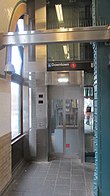
Southbound elevator inside
In February 2014, as part of an ongoing rehabilitation, the MTA built a ramp from street level to the mezzanine and opened an elevator to connect the southbound platform to the mezzanine.[13] The elevator, which was not originally planned in the station renovation, was built due to a lawsuit by the United Spinal Association.[14] The elevator is of a "machine room-less" design and is the first of its type to be installed in the New York City Subway system. The renovations also included rehabilitation of the tunnel portal, realignment and rehabilitation of the platforms and installation of new cast iron lighting fixtures.[15]
The southbound elevator is located at the southwest corner of Hillside Avenue, St. Nicholas Avenue, and Fort George Hill, and is accessible by a ramp to the station house.[16]
This station is not accessible to the disabled on the northbound side because the suit was settled only after the northbound side was already renovated, and in any case, the area's geography made it prohibitively expensive to add an elevator to the northbound platform.[17] Northbound accessibility was proposed in February 2019 as part of the MTA's "Fast Forward" program.[18]
References
^ "Station Developers' Information". Metropolitan Transportation Authority. Retrieved June 13, 2017..mw-parser-output cite.citation{font-style:inherit}.mw-parser-output .citation q{quotes:"""""""'""'"}.mw-parser-output .citation .cs1-lock-free a{background:url("//upload.wikimedia.org/wikipedia/commons/thumb/6/65/Lock-green.svg/9px-Lock-green.svg.png")no-repeat;background-position:right .1em center}.mw-parser-output .citation .cs1-lock-limited a,.mw-parser-output .citation .cs1-lock-registration a{background:url("//upload.wikimedia.org/wikipedia/commons/thumb/d/d6/Lock-gray-alt-2.svg/9px-Lock-gray-alt-2.svg.png")no-repeat;background-position:right .1em center}.mw-parser-output .citation .cs1-lock-subscription a{background:url("//upload.wikimedia.org/wikipedia/commons/thumb/a/aa/Lock-red-alt-2.svg/9px-Lock-red-alt-2.svg.png")no-repeat;background-position:right .1em center}.mw-parser-output .cs1-subscription,.mw-parser-output .cs1-registration{color:#555}.mw-parser-output .cs1-subscription span,.mw-parser-output .cs1-registration span{border-bottom:1px dotted;cursor:help}.mw-parser-output .cs1-ws-icon a{background:url("//upload.wikimedia.org/wikipedia/commons/thumb/4/4c/Wikisource-logo.svg/12px-Wikisource-logo.svg.png")no-repeat;background-position:right .1em center}.mw-parser-output code.cs1-code{color:inherit;background:inherit;border:inherit;padding:inherit}.mw-parser-output .cs1-hidden-error{display:none;font-size:100%}.mw-parser-output .cs1-visible-error{font-size:100%}.mw-parser-output .cs1-maint{display:none;color:#33aa33;margin-left:0.3em}.mw-parser-output .cs1-subscription,.mw-parser-output .cs1-registration,.mw-parser-output .cs1-format{font-size:95%}.mw-parser-output .cs1-kern-left,.mw-parser-output .cs1-kern-wl-left{padding-left:0.2em}.mw-parser-output .cs1-kern-right,.mw-parser-output .cs1-kern-wl-right{padding-right:0.2em}
^ "Facts and Figures: Annual Subway Ridership 2012–2017". Metropolitan Transportation Authority. July 12, 2018. Retrieved July 12, 2018.
^ "NPS Focus". National Register of Historic Places. National Park Service. Retrieved December 22, 2011.
^ {{cite work=The New York Times |url=https://wwwnytimes.com/1907/01/14/archives/farthest-north-in-town-by-the-interborough-take-a-trip-to-the-new.html |title=Farthest North in Town by the Interborough |date=January 14, 1907 |p=18}}
^ District, New York (State) Public Service Commission First (January 1, 1913). Report of the Public Service Commission for the First District of the State of New York. J.B. Lyon Company.
^ "Trains To Ship Canal: But They Whiz by Washington Heights Station" (PDF). The New York Times. March 13, 1906. Retrieved August 16, 2015.
^ [1]
^ "Express to 221st Street: Will Run In the Subway To-day–New 181st Street Station Ready" (PDF). Retrieved September 1, 2016.
^ Report for the three and one-half years ending June 30, 1949. New York City Board of Transportation. 1949.
^ "More Long Platforms – Five Subway Stations on IRT to Accommodate 10-Car Trains". The New York Times. July 10, 1948. ISSN 0362-4331. Retrieved March 27, 2016.
^ National Registar of Historic Places: New York County - Dyckman Street Subway Station (IRT)
^ "MTA Neighborhood Maps: Washington Heights" (PDF). Metropolitan Transportation Authority. 2015. Retrieved December 31, 2016.
^ Kabak, Benjamin (February 8, 2014). "Dyckman St. reopens as work affects 8 subway lines". secondavenuesagas.com. Retrieved August 3, 2016.
^ Kabak, Benjamin (July 21, 2011). "Dyckman St. accessibility suit settled". secondavenuesagas.com. Retrieved August 3, 2016.
^ "Ribbon Cutting Marks MTA NYC Transit's Rehab of Dyckman St 1 IRT Stop". MTA. February 6, 2014. Archived from the original on February 9, 2014.
^ "mta.info - Accessibility". mta.info. Retrieved August 3, 2016.
^ Dwyer, Jim (February 6, 2014). "A Moving Glass Box Conquers Uneven Terrain at a Subway Station". The New York Times. ISSN 0362-4331. Retrieved August 2, 2016.
^ mtainfo (February 6, 2019). NYCT Public Event - Discussion About the Next Accessible Subway Stations - 02/06/2019 (video) – via YouTube.
External links
| Wikimedia Commons has media related to Dyckman Street (IRT Broadway – Seventh Avenue Line). |
- nycsubway.org – IRT West Side Line: Dyckman Street
- nycsubway.org – Flight Artwork by Wopo Holup (1991)
- Station Reporter – 1 Train
- The Subway Nut – Dyckman Street Pictures
- MTA's Arts For Transit – Dyckman Street (IRT Broadway–Seventh Avenue Line)
- Dyckman Street entrance from Google Maps Street View
- Platforms from Google Maps Street View

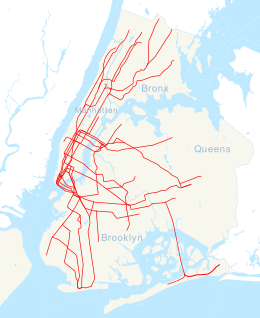
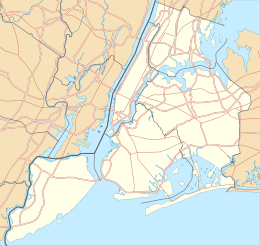
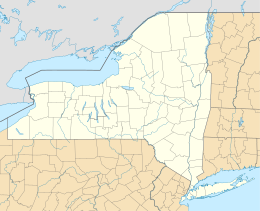
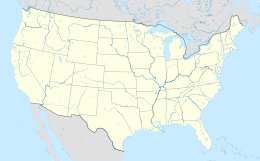





Comments
Post a Comment